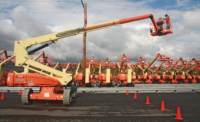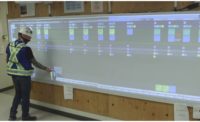In a market in which demand for heavy-lift cranes rises and falls with demand for large power, petrochemical and infrastructure projects, crane manufacturer Sarens is seeing enough consistent interest to warrant construction of the SGC-140, a massive crane even larger than the SGC-120 it introduced in 2011. With a load moment of 140,000 ton-meters and a maximum lifting capacity of 2,820 tons at 50 m, it is one of the largest capacity on-land cranes in the world.
“It is a tough market,” observes Carl Sarens, group director of technical solutions for the Wolvertem, Belgium-based manufacturer. “But Sarens still sees a future in cranes with even larger capacities. There is still an industry demand for these types of cranes.”
Working from the same basic design as the SGC-120 supercrane, the SGC-140 features several upgrades beyond the improved load chart. While the crane has the same geometry and boom as the SGC-120, it boasts a larger counterweight, tipping the scales at 4,000 metric tons. This added counterweight allows for the improved load-moment performance over the SGC-120’s, says Sarens. The counterweight is made up of shipping containers—filled with sand or gravel, sourced near the site—a feature of larger cranes that reduces transport costs.
The boom has three configurations: 89 m, 118 m and 130 m. The boom length can be increased with jib extensions, ranging from 40.5 m to 99.5 m.
The crane’s power systems have been upgraded to meet Tier 4 Final emissions standards, allowing the crane to be deployed in the U.S. without the need for additional emissions controls. The power system consists of six power-pack units: standard 20-ft shipping containers with two 260-kw Caterpilllar engines each.
In addition to fitting the emissions controls inside the profile of the power packs, the power system for the SGC-140 is also significantly quieter during operation than the SGC-120. Noise-mitigation materials were added to the containers’ panels, and a quieter exhaust system minimizes ambient noise. “It was a lot of engineering to fit hydraulics, engines … in the 20-feet containers,” recalls Sarens. “This design will be the minimal standard for all of our new cranes.”
Destined for a large industrial project in Kazakhstan for state-owned petrochemical giant TCO, the SGC-140 is expected to travel to other global customers that Sarens is in the process of lining up.
The previous crane in the line, the SGC-120, began its journey working on an Intel plant in Chandler, Ariz., in 2011, before heading to an industrial project in China, a nuclear plant in France and an oil-and-gas operation in Indonesia. After a few other stops, it is now used in offshore work in Newcastle, England.
“I think there will be increasing demand for these sort of cranes,” Sarens told ENR. “Many types of projects are scaling up, and there are lifts that cannot be done with a standard crane anymore. Power plants are always getting bigger with more capacity. It is not a downward trend in cranes now, and we need to have the top cranes in the world.”





Post a comment to this article
Report Abusive Comment